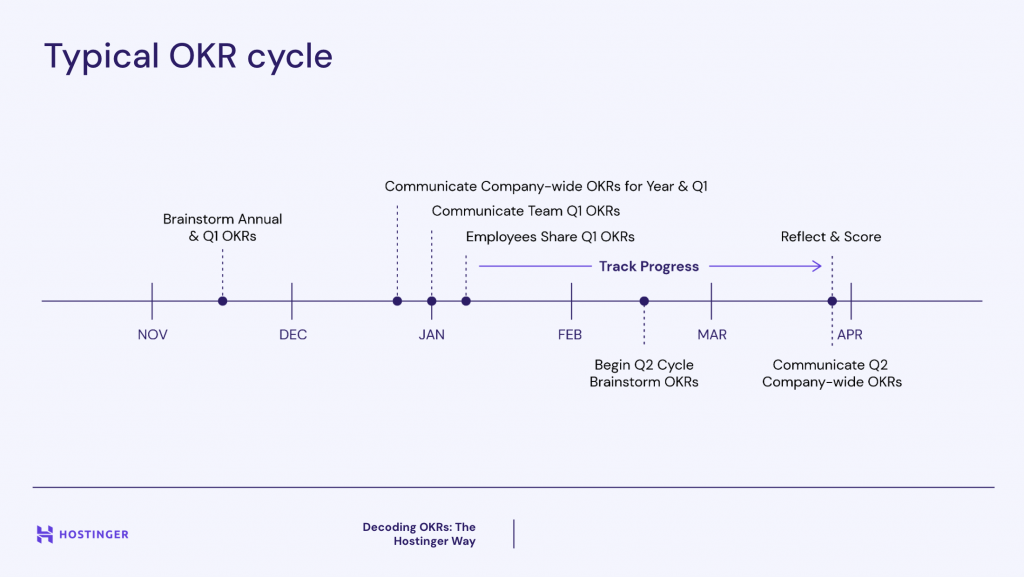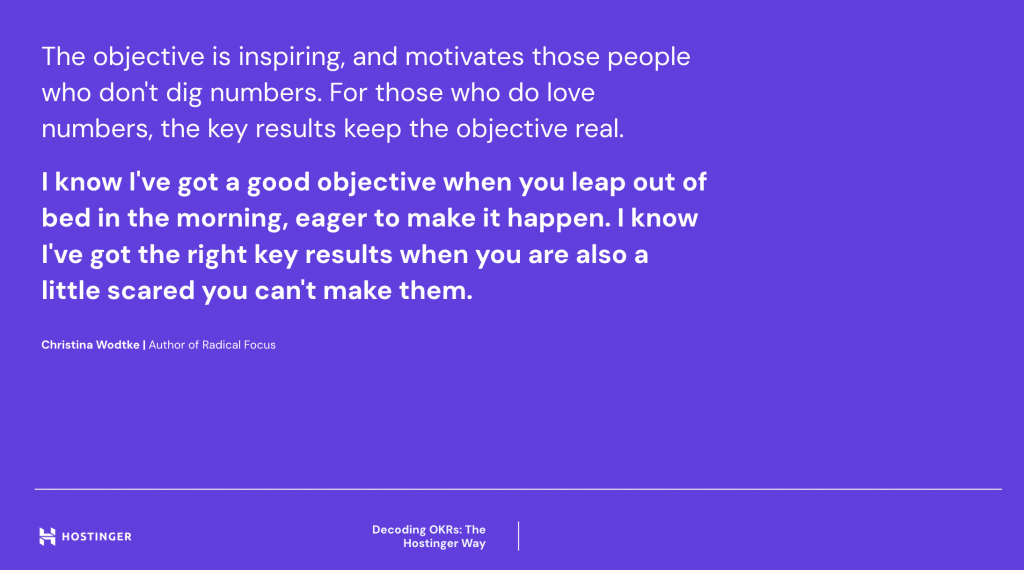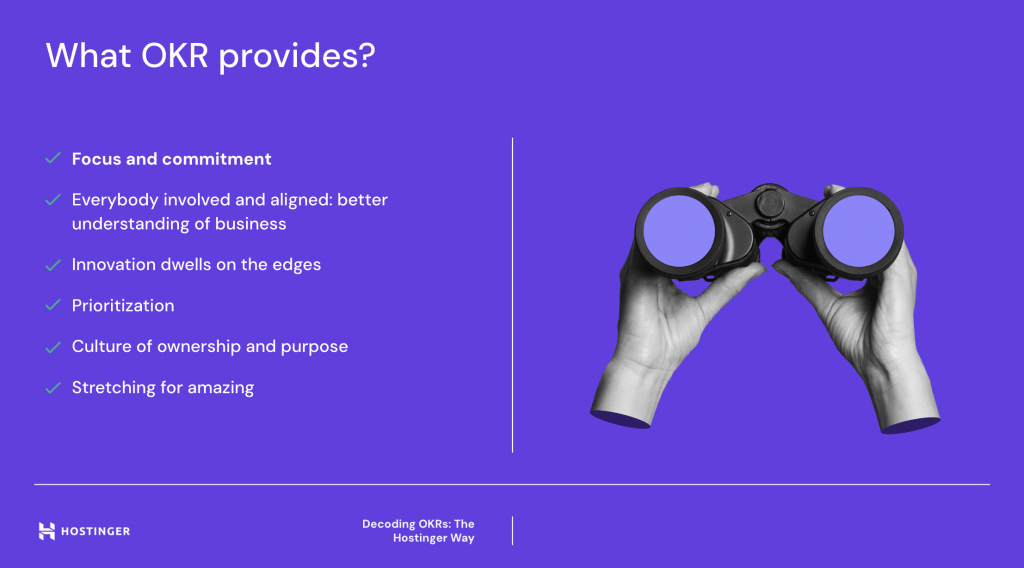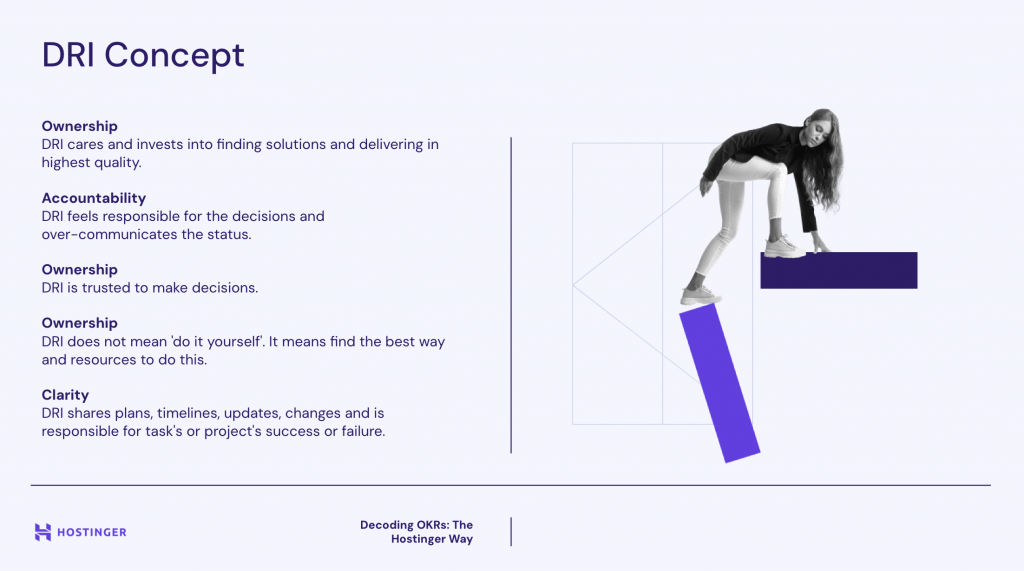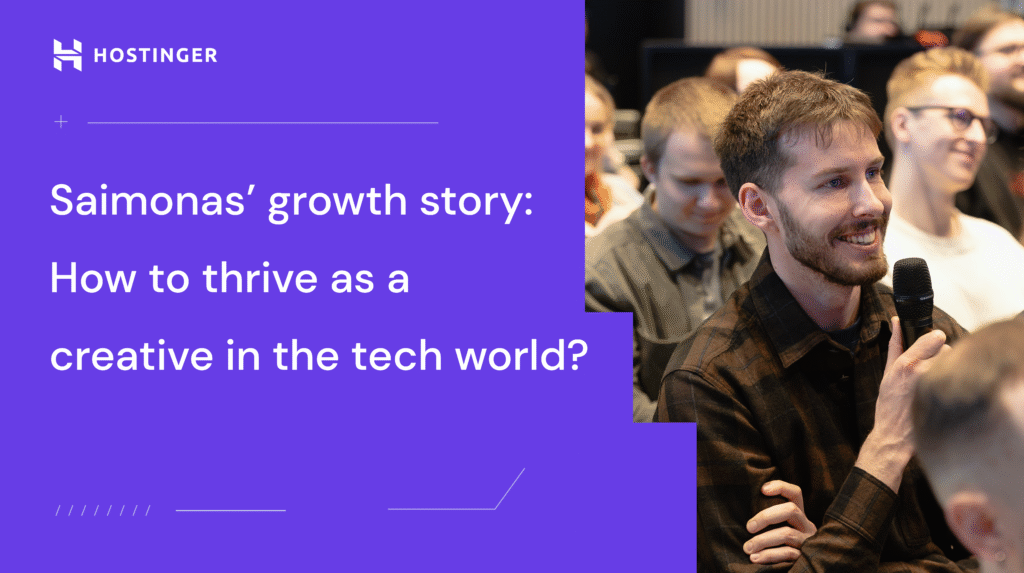Decoding OKRs: The Hostinger Way

In every organization, setting measurable goals for every team member is a significant challenge. How do we tackle this at Hostinger? Through the Objectives and Key Results (OKRs) framework. Keep reading to gain valuable insights from Hostinger’s OKR experts, Arnas Stuopelis, Chairman of the Board, and Giedrius Zakaitis, Chief Product Officer. They’ll be delving into everything OKRs, from top practices and advantages to the challenges we’ve encountered and overcome.
A Key to Remarkable Growth
“Six years ago, we had only 30 employees. We were full of good and ambitious ideas, but the team was juggling daily tasks without enough time to step back. Balancing innovation with routine was a constant challenge”, Arnas recalls.
Then, Arnas learned about implementing OKRs from his former colleague, who believed it would be a perfect fit for Hostinger. The team dived into research, watching countless videos and reading articles. Initially, Giedrius was skeptical and viewed OKRs as just another set of rules. “However, as I delved deeper and began applying them, I saw a huge impact”, he admits. This shift has been instrumental in Hostinger’s remarkable growth.
“Our initial OKR cycle wasn’t a smooth ride, especially in tracing results. For the first iteration in 2017, we started very enthusiastically but forgot to fill out the results after the quarter ended. By the second cycle, we improved a bit as our focus had sharpened, leading to higher client happiness scores and faster response times. With other attempts, we started having Directly Responsible Individuals (DRIs) – people who are responsible for any particular project. This concept, borrowed from Apple management practices, drastically helped with OKR planning.
Now, we have forked what’s best from OKRs and merged it with other best practices, such as input/output metrics. Inspired by the Amazon book “Working backwards”, they have Hostinger’s flavor of OKRs. That is still a continuous process of learning and improving, but OKRs are an integral part of our operations. They are one of the key contributors to reaching 2.5 million customers worldwide by 2024”, Arnas shares.
Understanding the Foundation of OKRs
Established at Intel in the 1970s, OKRs have become a cornerstone management tool thousands of organizations use worldwide, from Spotify to the United States Navy.
Simply put, OKR is an objective management framework that involves setting ambitious goals and tracking progress through measurable results, applicable at every organizational level, from company-wide to individual ones. OKRs empower actions aligned with both the company’s interests and personal development. The main difference in planning with the OKR approach is frequency, as we do it quarterly, and the highly structured flow.
The OKR cycle is a quarterly process involving several steps:
- Identifying desired goals. Determining the most crucial goals you want to achieve in the next quarter.
- Transparency. Writing down the objectives and making them public.
- Focus. Maintaining an extreme focus on the set objectives.
- Reflection. Regularly reflecting on progress.
- Repetition. Repeating the process for continuous improvement.
It is essential to understand OKR components to grasp how they facilitate business improvement:
- Objective. It defines the goal and sets the direction toward it. A good objective must be inspiring and motivating.
- Key results. Also known as the process indicators, they are not tasks but results from actions quantified by specific numbers. They indicate progress toward the objective.
- Initiatives. These are specific tasks we need to do to achieve key results.
Adopting the Best Practices
We’ve embraced the best practices from leading companies like Amazon, such as input and output metrics for clarifying objectives and streamlining processes during OKRs. Output metrics represent the results or outcomes, while input metrics denote the actions taken to achieve these outcomes.
Outputs let you know where you want to go, but they’re out of our control. Outputs are critical in the planning, project management, and evaluation processes. While inputs are controllable, they alone don’t always lead to results; they need something to work toward. Inputs and outputs work together as cause and effect when achieving business goals. Together, they accomplish either part of or the entire OKR.
Another critical aspect of OKRs is choosing between a bottom-up or top-down planning approach, which depends on the organizational structure. For manager-led organizations, a top-down approach might be more beneficial. Whereas organizations without managers, such as early-stage startups or some non-profit collectives, usually adopt a bottom-up approach. At Hostinger, we find the hybrid model most effective.
“This model engages every team member and leader in contributing ideas. For the whole planning cycle, it takes around one month. First, the CEO and Leadership team synthesize ideas, identify key focus areas, and establish company-wide priorities and OKRs objectives for upcoming Q. After that comes Hostinger Focus week, which is dedicated to team and 1on1 meetings, and intensive planning company-wide, ensuring a collaborative and comprehensive process. During this week, all teams establish department, team, and personal OKRs. Right after that, the CEO and the leadership team make final adjustments, give feedback, and align it with other teams,” Giedrius details how it works at Hostinger.
Unlocking Growth and Empowerment
Giedrius highlights the profound impact of OKRs at Hostinger, emphasizing that they have evolved beyond mere methodology. Both Arnas and Giedrius emphasize how OKRs have been pivotal in accelerating our company’s growth and driving improvements:
- OKRs have been instrumental in identifying what to do and what not to do. Key breakthroughs have been recognizing the most impactful tasks and understanding the implications of not pursuing specific actions.
- We shifted to a more structured approach. Instead of interrupting workflows with spontaneous ideas, we document them during dedicated OKR planning sessions, fostering a more organized and creative thought process.
- OKRs allow individuals to set their own goals, fostering a sense of ownership and accountability. This boosts motivation and productivity.
- OKRs keep team members engaged, constantly learning, and seeking new challenges. Embracing challenge and continuous learning is the essence of our approach.
Embracing Ambitious Goals
Ambitious goals push us to think creatively, learn, and network. “We’ve always aimed for significant growth, often facing failure and skepticism. However, those who persevere through initial setbacks tend to exceed their goals. If all OKRs are met without fail, it might indicate that the goals are not challenging enough”, Arnas explains.
Echoing the sentiment of the book The 10X Rule, which states, “If you are not first, you are last. Average is a failing formula,” Arnas advocates for pushing limits and then taking well-deserved rest.
Delving into different types of OKR goals, Giedrius explains what is used at Google and other industry leaders:
- Moonshot goals. These are ambitious targets slightly beyond what seems achievable, with a 60-70% completion considered successful. You can achieve them only if you execute everything to perfection and have luck or external factors helping you.
- Roofshots. Challenging yet attainable, you should achieve 100% of these goals.
At Hostinger, we primarily focus on moonshot goals, setting targets that initially appear impossible and uncomfortable but drive significant progress. Reaching 100 % means that, most likely, you were not ambitious enough when planning (70 % or 0,7 of the target is a good result).
OKR scores are not the sole measure of performance. “While OKRs provide valuable insights into achievements, they shouldn’t be the only metric for employee performance evaluation. Over-reliance on OKRs in performance reviews can lead to conservative goal-setting, thereby diminishing the model’s potential benefits,” Giedrius says.
Pitfalls to Avoid
Giedrius highlights that OKRs are not some silver bullet that can fix everything. They require a solid foundation of company culture, values, and principles. These are necessary for OKRs to drive growth. Both Giedrius and Arnas highlight common pitfalls to avoid and share key insights for effective OKR planning:
- Continuous process. The main pitfall to avoid is setting and forgetting OKRs. Organizing OKRs should be an ongoing process, not rushed into the last few weeks. A steady flow of ideas leads to better decision-making during planning sessions.
- Regular engagement and assessment. Treat OKRs like a consistent exercise routine for optimal health. Regular assessment is crucial. Otherwise, an organization might miss identifying and addressing issues on time and suffer greater damage, whereas regular reviews enable timely adjustments and focused efforts. The same goes for customer obsession. Consistent and meaningful interactions with clients, such as setting regular client interviews, are crucial to understanding their needs and emotions, fostering a stronger connection, and potentially increasing customer loyalty.
- A realistic number of the objectives and key results. Avoid overloading with too many objectives or key results. One or two key priorities ensure more focus and effectiveness.
- Customization. Tailor your OKRs to fit your unique needs. There’s no strict need to adhere to the book. Customize them with elements like continuous tasks, impact assessment, effort levels, priorities, and mini-task management for effectiveness.
- Prioritization amidst unplanned work. OKRs should encompass about 70% of your workload, allowing flexibility for unexpected tasks. When unplanned work arises, evaluate its alignment with your OKRs, broader team, or company objectives before committing.
- Have a timeline. Initiate tasks that require extensive communication early in the OKR cycle, while tasks that can be completed independently might be scheduled towards the end. This approach ensures adaptability and responsiveness to changing priorities and tasks.
- Assign directly responsible individuals (DRIs). It is crucial for ensuring ownership, accountability, empowerment, collaboration, and clarity. DRIs are responsible for the success or failure of their tasks or projects.
Integral Part of Hostinger DNA
Giedrius and Arnas emphasize that when it comes to OKRS, commitment and persistence are crucial – you might not reach what you planned within the expected OKR timeline, but it will happen eventually, as our practice shows.
Hostinger’s innovative approach to OKRs blends ambition with adaptability as we set challenging objectives that push the boundaries of what’s considered achievable. Arnas and Giedrius agree that OKRs catalyze growth, innovation, and personal fulfillment, which are integral to our organizational DNA.
Learn Even More About OKRs:
1. Measure What Matters: The Simple Idea that Drives 10x Growth by John Doerr
2. Google’s OKR Playbook
3. How to Write OKRs That Don’t Suck by Adrian Howard
4. How to Set Winning Sales Goals Using OKRs
5. OKR Training Course by Bhavin Turakhia (video)
6. Radical Focus and OKRs With Christina Wodtke (video)

